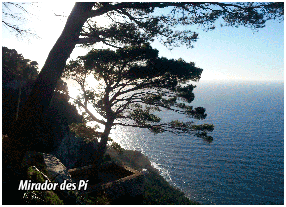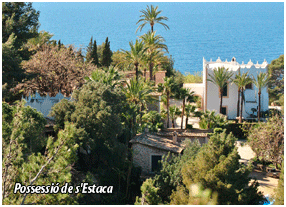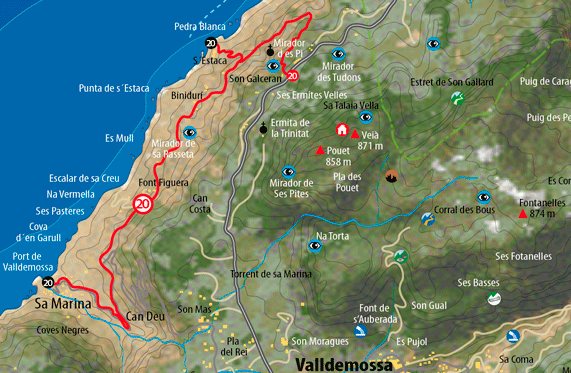From the Western corner of the Hotel, descending some deteriorated, anonymous steps. After "Es Vantage point d'es Pi", a very exposed path and some benches that are sheltered by the cornice, leaving behind on the left a refreshment area which we will visit later. At a forking of paths, select the option on the left. Then, immediately at another fork follow to the left. From the chapel, go up a few stairs that leave is at the same refreshment area we passed before. Going up along the slope, linking to the same path as before. Continue to the left until we reach the same fork; this time disregard the option on the left (which we selected before to go to the Chapel) and continue until Miramar M on the right. After a few minutes and disregard the deviation that descends on the left, go up some steps made of sticks. Situated at "Els Pontets de Sa Font Coberta"; bridges between which a rushing stream flows, look for other steps made of sticks situated near the same stairs as we have just gone up. After a staggered path which rises via the cornice (Coves de Ponent), the route reaches the monastery of Miramar. If we are looking at the sea, walk to the right until finding a horseshoe-shaped vantage point. From there follow "Es camí d'es Guix" which goes down on the left. After another vantage point, we reach a fork which is hard to spot; disregard the path that goes down on the right and go straight down in the shade of the helm oak grove via an unmarked path. After an area with debris, cross a water course. Go straight on and link up with a marked path that must be followed on the right. After "Es Vantage point d'es Creuer", go down a path which is very exposed. After around 10´, we reach "Camí de Ses Vinyes", a paved track that goes down to Caló de s'Estaca. Then retake the same track until reaching the property of s'Estaca which we recognise from its white colour. Carry on along cami de ses Vinyes, after some barriers and beautiful properties, we reach an asphalt track which must be descended until reaching sa Marina de Valldemossa, the goal of the route. The route starts at a modern building which is raised at the same place where in 1873, the Archduke had an old inn built popularly known as Ca Madò Pilla for visitors who wished to discover said spots. In the interior of the hotel is the s’Hostatgeria Vantage Point and a few metres away from the establishment, on the other side of the road, Camí de sa Muntanya starts which would take us to the elegant d’es Tudons vantage point. Half a kilometre after the chapel of Beat Ramon Llull, our route will meet the beautiful property of Miramar; an enigmatic enclave which, despite being situated near the road, lies unnoticed, hiding away in the lushness of its beautiful gardens. |
A stone bridge crosses the void as far as the rock. After the surprise of finding such a notable construction in this vicinity, we are overwhelmed by disappoint when we see the deplorable state of the monument; a bolt of lightning partially destroyed it in 1975. The cupola has been lost and the walls are in a very poor state of repair. The building was created to commemorate the sixth centenary of the foundation of Miramar. The first stone, brought on purpose from Bugia, was set up on January 21st 1877. This small oratory, circular in shape, was covered by a chronic roof and a shrine decorated by mullioned windows. The base of the monument can be gone round very carefully throughout its perimeter, though the railing is very rusty and incomplete. A marble statue of the Majorcan thinker presided over the interior space, decorated by a lot of detail. In the refreshment area of the chapel, we take advantage to have a rest surrounded by a memorable scenario. We recover the path we have left behind us and at a fork on the right we go up the little path that rises at the base of a holm oak. Between scrubland, pines trees and cliffs, Camí de Sa Torre runs along Comellar de Sa Rota where the path takes in a lush helm oak grove. If we look upwards, in the distance we will then see the landmark houses of Miramar; arranged on a cliff, oriented seawards. Once left on the right the remains of Pedrissos de s’Entreforc and immediately after ruling out another path which diverts to the left, we will enter the beautiful property of Miramar to behold Pontets de Sa Font Coberta, built by the Archduke, constituting one of the most representative examples of the hydraulic heritage of Sierra de Tramuntana. Said construction consists of thirteen bridges arranged transversally along a series of terraces. Referring to each of the 12 disciples and Jesus Christ, they were built to be able to cross the stream of sa Font Cuberta and thereby be able to cultivate the terraces of the two parts of the stream. |
20th Hiking Route around Sóller More than a hiking route, it could be described as a cultural route that tours the beautiful spots of Archduke Lluís Salvador d'Habsburgo-Lorena i Borbó (1847-1915). A noble of the Habsburg Lorena Dynasty, he was a great adventurer who, with his two sailing ships Nixe 1 and Nixe 2, became an explorer of the world. A great aficionado of the humanities and sciences, in 1867 whilst visiting Mallorca, he was bowled over by the beautiful spots in this area of the Majorcan coast. After a few years, he returned to Mallorca to acquire various properties in which he ordered the construction of an extensive network of former paths, vantage points, huts and refuges so that walkers could get to know this beautiful place. You'll be surprised when seeing the magnificence and greatness of the whole and the state it is in. What's more, we will get to know s'Estaca and es Caló, two places which are unique owing to their own charm. We will complete the day in the little valley of Sa Marina, a distant coastal town.
After an era, Camí Nou de s’Estaca ends and comes out onto Camí de Ses Vinyes which presents itself in the form of a paved track and at the next curve we run into an enticing path “És camí de la mar” which starts on the right and which would take us along the d’es Guix area as far as Sa Foradada. We leave this option for another occasion and after a comfortable descent via said asphalt track we discover a seaside village which will captivate us. Es Caló de s’Estaca was the shelter of fishermen for years, though today they have been converted into summer homes. The image as a whole seems to have been frozen in time, external to the rest of the world. In this coastal area survival was never easy and man, depending on his resources and the sea, was devoted to fishing or agriculture, also seeking some additional benefits in estraperlo, a clandestine activity which is firmly rooted in the area. It would not be possible to abandon these spots without taking a bath in its crystal-clear water and enjoying the peacefulness of the spot. Following the same route we return to the crossroads of Camí de ses Vinyes and after ascending a few paces more, we are surprised by the property of s’ Estaca where, alongside the path, there lies a large rock which indicates to us an inconspicuous path which, on the other side of the path, reascends the mountain, disappearing into the helm oak grove. It is called Camí de sa Barrera de sa Marina which, after several further vantage points and an intense ascent, would take us back to the same road where we started our walk. We disregard this option and follow the new Estaca track. This final part of the route will undoubtedly prove to be one of the most comfortable on our journey. After an adobe wall, we bid farewell to the landmark property of s’Estaca and its beautiful malvasía vines. Then we run into some metallic barriers which we cross on the right. After ses Cases d’es Sementer de sa Garrovera we run into a beautiful, stand-alone possessió (former rural estate) which in 1898 also formed part of Arxiduc. It is currently a residential villa; its name Sa Font Figuera derives from a rushing stream which flows between the houses of the property and the sea. Whilst the walls d’es Teix are raised in the background with its alpine majesty, over a cliff, another vantage point will draw our attention; it is Erassa vantage point. After two lime kilns, Camí de Ses Vinyes runs out into the road of Port of Valldemossa which we descend until reaching our destination. |
||||||||||
See Description of the Route |
||||||
 |
||||||
|
||||
|
||||



